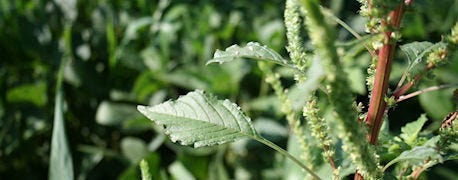
The first light at the end of the tunnel for Palmer amaranth control became apparent when Bill Johnson talked to Indiana Certified Crop Advisers recently. Johnson is a Purdue University Extension weed control specialist.
Don't get the wrong impression – Palmer amaranth is serious, especially if you already have it or know it's in your area. Johnson says treat all of it as if it's glyphosate-resistant and build a program that relies heavily on residual herbicides. If you're going to hit it again post, it's critical to spray it before it passes the 4-inch height, he says.

Just one of several tough weeds: Nobody denies that Palmer amaranth is a serious threat in areas where it is established. However, Bill Johnson says you also need to focus on controlling other weeds, including giant ragweed.
Johnson and his co-workers have studied Palmer amaranth carefully in plots near Twelve Mile in Cass County. A field became infested there because the seed likely rode north from the Deep South on cottonseed meal. There is a large dairy directly across the road from the infested field which has been rented by chemical companies so that plot work can be done on the weed.
Related: Telling Palmer Amaranth From Waterhemp
So where's the beam of hope? Johnson says that amaranth is more of a desert-type plant if it has its druthers. It prefers warmer, even drier weather. That doesn't mean it won't do well in Indiana, but he believes it may indicate that it may not reach the out-of-control level that it has in the southern U.S. where the climate is much warmer most of the time.
In the coffee shop, it is known as Palmer pigweed. In university circles, it is referred to as Palmer amaranth. Whatever you want to call it, this weed is the No. 1 weed to watch. Stay on top of your control plan with our new free report, Palmer Amaranth: Understanding the Profit Siphon in your Field.
What he hopes is that farmers don't get so wrapped up worrying about Palmer amaranth. While it's a serious threat, farmers shouldn't forget about best controls for other weeds, including marestail and tall waterhemp. Marestail also has resistance issues, and unless you get it early, it can escape control in soybean fields.
Related: Take on 2015 Weed Control Planning Early
The sleeper weed may be giant ragweed, Johnson says. It also has resistance capabilities, and is still a large problem across much of Indiana. He recommends remembering these other weeds when designing your weed control program for 2015.
Don't get so wrapped up in Palmer amaranth that your forge that marestail, waterhemp and giant ragweed can also take over fields if given the chance, he concludes.
About the Author(s)
You May Also Like




